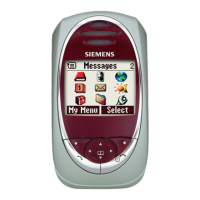Customer Care
V 1.0 Page 33of 52 ICM MP CCQ GRM
SL55
Company Confidential © Copyright Siemens AG
06/03
6.2 Battery
As a standard battery a LiIon battery with a nominal capacity of 3,7 Volt/700mAh is used.
6.3 Charging Concept
6.3.1.1 Charging Concept
General
The battery is charged in the unit itself. The hardware and software is designed for LiIon
with 4.2V technology.
Charging is started as soon as the phone is connected to an external charger. If the
phone is not switched on, then charging takes place in the background (the customer can
see this via the “Charge” symbol in the display). During normal use the phone is being
charged (restrictions: see below).
Charging is enabled via a PMOS switch in the phone. This PMOS switch closes the circuit
for the external charger to the battery. The EGOLD+ takes over the control of this switch
depending on the charge level of the battery, whereby a disable function in the POWER
SUPPLY ASIC hardware can override/interrupt the charging in the case of over voltage of
the battery (only for Manganese Chemistry Battery types e.g. NEC).
With the new slim Lumberg IO connector the charger recognition via SB line is lost. Now
the charge current is measured inside the POWER SUPPLY ASIC with a current monitor.
The charging software is able to charge the battery with an input current within the range
of 350-600mA. If the Charge-FET is switched off, no charging current will flow into the
battery (exception is trickle charging, see below).
For controlling the charging process it is necessary to measure the ambient (phone)
temperature and the battery voltage. The temperature sensor will be an NTC resistor with
a nominal resistance of 22kW at 25°C. The determination of the temperature is achieved
via a voltage measurement on a voltage divider in which one component is the NTC. The
NTC for the ambient temperature will be on the PCB (26 MHz part).
Two Wire Interface (TWI):
The TWI bus interface in configured as a slave unit with 1bit INT (interrupt), 1 bit SDA (serial data) and
1 bit SCL (serial clock). The data and the address of the register files are defined including read/write
bit, control status bits( like ON/OFF, EXT_PWR, CHARGE...). The TWI interface is asynchronous with
the internal clock. The TWI interface is reset with POR condition or falling edge of RESETN signal.
Charging current
Charging control signal
Operating voltage for Trickle charge

